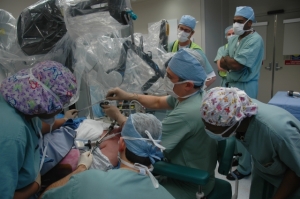Robot Mouth Surgery Gets FDA OK
by
Brendon Nafziger, DOTmed News Associate Editor | December 24, 2009

The da Vinci surgical
robot at work
A minimally invasive surgical technique for mouth and neck cancers that uses a robot got the nod from the FDA last Friday, according to a statement from the University of Pennsylvania.
Called TransOral Robotic Surgery, or TORS, the now FDA-cleared procedure uses the da Vinci surgical robot, made by Intuitive Surgical in Sunnyvale, Calif. Physicians can use this machine, which helps magnify tissue and is controlled remotely, to introduce surgical instruments into the mouth and slice out benign and malignant growths from the mouth, larynx, tongue and throat.
Better outcomes
Although radical surgery is often the best treatment for these cancers, surgeons usually have to slash "ear-to-ear" across the throat and even smash up the jaw to get at tumors in the neck or mouth.
"In normal surgeries, for a tumor in the back of your throat, they have to put huge cuts in your neck, break your jawbone and split it aside, and cut out large pieces of not only the tumor, but normal tissue as well, and then put it all back to together," says Dr. Bert O'Malley, Jr., a surgeon and co-developer of the technique. He chairs Penn Medicine's department of otorhinolaryngology, or head and neck surgery.
This invasive, though often necessary, operation requires lengthy healing time and exposes the patient to the usual surgery-related risks of infection. It can also result in lasting speech deficits and problems swallowing.
"Anywhere from 10 to 30 percent of patients can't swallow ever on their own -- for life," Dr. O'Malley says. This means patients need a peg tube permanently inserted into their stomachs for feeding. Often patients will also require a tracheotomy.
Because of these drawbacks, many doctors now treat throat or mouth cancers exclusively with high doses of chemotherapy and radiation. But Dr. O'Malley says these are often less effective when not used as an adjunct to surgery, and can still cause many of the same side effects, such as trouble swallowing or difficulty speaking.
"Nine to 30 percent [of patients] have chronic use of peg tubes for standard radiation protocols," he says.
This is where the surgical robot comes in. In their most recent study, still not complete, Dr. O'Malley says using the machine around 98 percent of patients could swallow following surgery.
And he was also able to cut the number of people getting post-op chemo or radiotherapy, as well as the strength of the doses, for those who had malignant growths taken out.
"In our study for cancer, 65-70 percent still needed radiation," he says. "But of these, only 30 percent needed chemo, versus 100 percent before." That's important, Dr. O'Malley says, because the combination of chemo and radiation is the most destructive.
